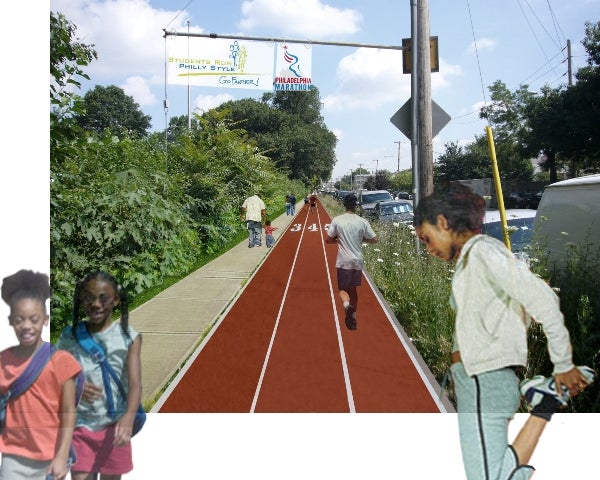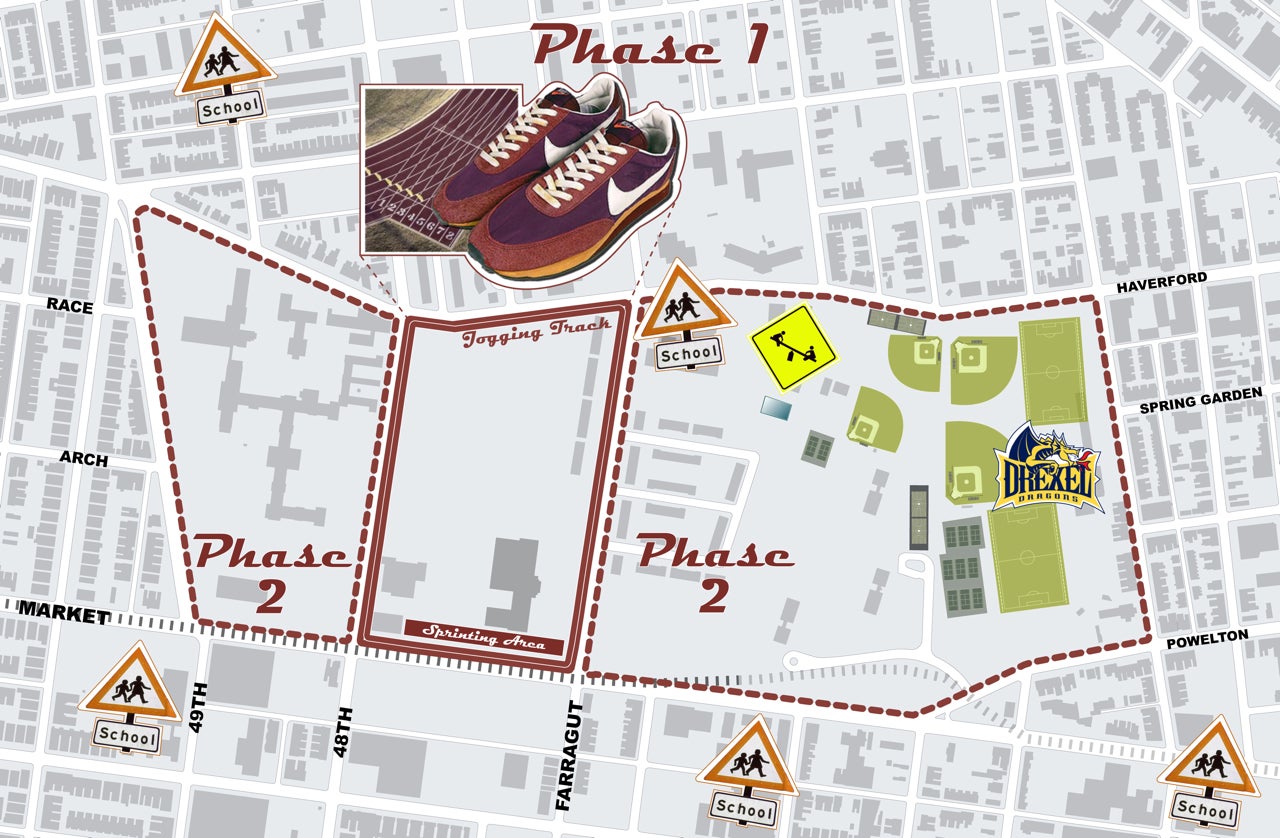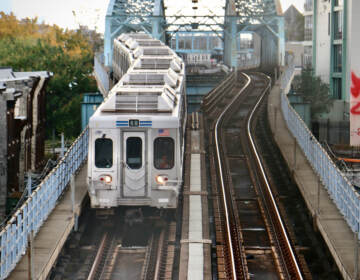TOD: its day has come

Interface Studio / proposed running track at 46th Street Station. See current conditions in slide show at upper right.
May 26
By John Davidson
For PlanPhilly
Rising gas prices, a growing concern for the environment and a renewed interest in urban living and best practices has helped raise awareness of mass transit and how it can be best employed in a built environment.
In Philadelphia, transit-oriented development – or TOD in planning and design circles – is a topic of increasing discussion as Mayor Michael Nutter pushes to create “the greenest city in America.”
In order to accomplish this, it will require, among other things, placing mixed-use, pedestrian-friendly, high-density developments near transit hubs. Not only as a way to reduce traffic congestion and pollution, but also in order to make neighborhoods safer, more livable and more sustainable in the long term.
But decades of decentralization and neglect have left areas around many of Philadelphia’s transit hubs underdeveloped. Despite one of the top five largest regional rail networks in the country, the city has virtually no transit-oriented developments and lags behind other cities its size.
According to Richard Voith, a vice president of the economic-consulting firm Econsult Corp. and former vice chairman of SEPTA’s board, the best opportunities for TOD in the city should be along the Market-Frankford and Broad Street el lines–areas that are instead marked by auto-oriented development: “Just about the worst kind of things you would want around those stations.”
In the early 20th century, explains Voith, these areas of Philadelphia were built up around transit. But as the city struggled through the 1970s and ’80s, those were the neighborhoods that declined sharply, leaving transit hubs underused and in some cases all but abandoned. An auto-oriented outlook exacerbated the problem.
Says Voith: “In the ’80s there was a whole mentality in the city that said, ‘we have to adjust, we have to become much more like the suburbs, we have to be car-friendly.’ Transit was an uncertain business and it wasn’t even clear whether SEPTA was going to survive. And so what you saw was just complete decline around those neighborhoods and then reconstruction. Frequently it was a Rite Aid, Popeye’s drive-through, a grocery store with huge parking lots–things that are completely antithetical to transit-oriented development.”
It wasn’t until the mid- to late-90s that attitudes about cities began to shift and people began to reconsider the role of urban centers, that maybe they should not be just like the suburbs and maybe transit should be seen as an asset.
“I think people are really, seriously starting to think about that now,” Voith says, citing the Cira Center and the Comcast building as recent examples of commercial TOD in the city.
He also thinks it’s wrong to focus on the negative right now because, with a relatively stronger real estate market than Philadelphia has seen in years (the recent housing crisis notwithstanding), there are an increasing number of opportunities to develop around transit and an increasing interest in TOD among developers and city leaders.
“We’ve put things in place, we’ve put leadership in place–at SEPTA and the city and the state–that actually cares about this,” Voith says. “So wherever we’ve been, which has not been very good… that has changed.”
A crucial part of that change has been the resurgence of SEPTA. In the last decade, apprehension on the part of developers to build near transit was due, in part, to uncertainty about whether SEPTA would even survive, according to Voith. But with the transit agency on firmer financial footing thanks to recent state legislation, it is now in a position to be an asset to developers rather than a liability.
“SEPTA has emerged from a survival mode to a mode of, ‘lets see whether we can be a part of city and regional solutions,” says Voith.
For his part, SEPTA General Manager Joseph Casey says his agency wants to see more transit-oriented development in the region, and is committed to doing its part to improve infrastructure to encourage it.
“The more people we can get, whether it’s residential or businesses, around transit hubs the better off we are and the better off the environment is in the region,” Casey says. “And I think there is a renewed interest from developers’ standpoint; they really understand the importance of having transit near their development.”
Most recently, federal stimulus dollars are helping SEPTA make lighting and shelter improvements along the Chestnut Hill line, and more infrastructure improvements are planned throughout the city.
Casey recognizes the renewed interest in TOD and cites several major commercial developments in the city as examples of a growing trend: “If you look at some of the major construction projects … they are all being developed around transit hubs. You look at the Comcast building -that was right outside suburban station; you look at 30th Street, where they built the Cira Centre; and they’re also building the IRS offices out near 30th Street. We support that, it encourages ridership and gets cars off the road.”
Although the Comcast and Cira buildings are shining examples of commercial TOD, Philadelphia is sorely lacking good examples of residential TOD. There are, however, plenty examples of the opposite: residential transit hubs that are all but disconnected from city neighborhoods and pedestrian use.
Bev Coleman, Executive Director of NeighborhoodsNow and an outspoken advocate for transit-oriented developments in middle- and low-income neighborhoods, points to the el stop at Broad and Girard streets as a perfect example of what’s wrong.
“On two of the corners, on the north corners, you have two drive-thru, fast food restaurants,” Coleman said. “Well, why do you need such an auto-oriented use at a transit hub?”
Coleman and other TOD advocates are hoping that well-crafted city and state legislation will not only prevent future Broad and Girard-type of developments, but will also provide incentives for developers to pursue pedestrian-scale developments near transit hubs.
A 2004 state law established a framework for such incentives in the form of a “transit revitalization investment district” (TRID). Basically, it works like a TIF (“tax increment financing” zone) wherein incremental taxes are set aside for specific projects. Through TRID, the city and SEPTA would have to work together to establish “value capture” zones, in which a portion of the tax revenues would be used for public transportation capital improvements, site development and maintenance.
One of the ways this legislation might work better, says Voith, is if state tax dollars were set aside for TRID, rather than city taxes. “It would help a lot in increasing the economic viability of TOD.”
Thus far, no TRIDs have been established in Philadelphia, but last year the architecture firm Interface Studio worked with NeighborhoodsNow on a TRID pilot project for 46th Street Station and the Temple Regional Rail Station. The plans that Interface drafted are now being used by neighborhoods to engage the city in conversations to establish TRIDs in those areas.

According to Scott Page of Interface Studio, a key factor in the project was getting the neighborhood residents involved. That, he says, will be necessary to any successful TRID plan.
“Engaging the community–planning with them, not for them. That goes a long way towards getting community buy-in and support, but also empowering the community groups to raise money to make some of these improvements.”
Of course, if you have sufficient capital and patience, a community buy-in isn’t necessary for TOD. Developer Bart Blatstein’s mammoth mixed-use complex at 2nd and Hancock, The Piazza at Schmidts, is perhaps the best example of a high-density, mixed-use TOD in the region: a $150 million complex on about 30 acres that includes 35 artist’s studios and boutiques, four new restaurants, 500 apartments and 50,000 square feet of office space– all within walking distance of the Girard Station on the Market-Frankford line and the Girard Avenue streetcar line.
Situated around Germantown Avenue and Second Street, Blatstein is fond of describing his Northern Liberties TOD development as a “five minute community” because residents can dine, work and play within five minutes of their home.
The piazza itself is a shining example of new urbanism: 80,000 square feet of public space encompassed by first-floor restaurants, shops and artist spaces. Blatstein says the piazza will host regular concerts, open-air markets and movie nights, indie films and sporting events on a 16×26-foot HD LED video projection screen. It’s all part of Blatstein’s vision of a teeming urban community. Having grown up in a row house, Blatstein says he walked everywhere. He doesn’t care for the term ‘new urbanism.’
“There’s no new urbanism,” he says. “It’s just the way things were.”
Contact the reporter at jddavison9@gmail.com
WHYY is your source for fact-based, in-depth journalism and information. As a nonprofit organization, we rely on financial support from readers like you. Please give today.






